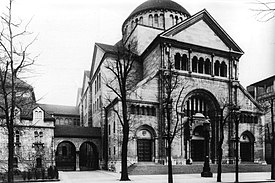Fasanenstrasse Synagogue
| Fasanenstrasse Synagogue | |
|---|---|

Fasanenstraße Synagogue about 1916
|
|
| Basic information | |
| Location | Fasanenstraße, Charlottenburg, Berlin |
| Geographic coordinates | 52°30′16″N 13°19′41″E / 52.50444°N 13.32806°ECoordinates: 52°30′16″N 13°19′41″E / 52.50444°N 13.32806°E |
| Affiliation | Liberal Judaism |
| Status | Closed by the Nazis in 1936, burned during Kristallnacht in 1938, destroyed during Allied bombing in 1943 |
| Leadership | Former rabbis included Leo Baeck |
| Architectural description | |
| Architect(s) | Ehrenfried Hessel |
| Architectural style | Neo-Romanesque with Byzantine elements |
| Completed | 1912 |
| Capacity | 1,720 |
The Fasanenstraße Synagogue was a liberal Jewish synagogue in Berlin, Germany opened on 26 August 1912. It was located in an affluent neighbourhood of Charlottenburg on Fasanenstraße off Kurfürstendamm at numbers 79–80, close to the Berlin Stadtbahn and Zoo Station.
The fast-growing Jewish Community in Charlottenburg purchased the premises in 1905 and following an architecture competition the synagogue was built from 1910 on in a Neo-Romanesque style (similar to the nearby Kaiser Wilhelm Memorial Church) with three domes and distinctive Byzantine elements. Finished in 1912, the monumental structure was large enough to accommodate up to 1,720 worshippers and also included a religious school.
While older synagogues – such as that on Rykestrasse – had usually been erected in backyards, the temple with its richly decorated frontage was intended as a visible statement of Jewish emancipation in the German Empire. Rabbi Leo Baeck was one of its leaders. Its main cantor for many years was Magnus Davidsohn and Richard Altmann (who was blind) was its organist.
Emperor Wilhelm II presented the synagogue with a ceremonial marriage hall richly adorned with Maiolica tiles from his manufacture in Kadinen, dedicated to the Jews of Germany, and, as Magnus Davidsohn's daughter, Ilse Stanley, describes in her book The Unforgotten, visited the temple upon its opening. Kurt Tucholsky on this occasion mocked "the patriotic synagogue" criticizing a voluntary assimilation of German Jews while the ruling class had nothing but contempt for them.
...
Wikipedia
